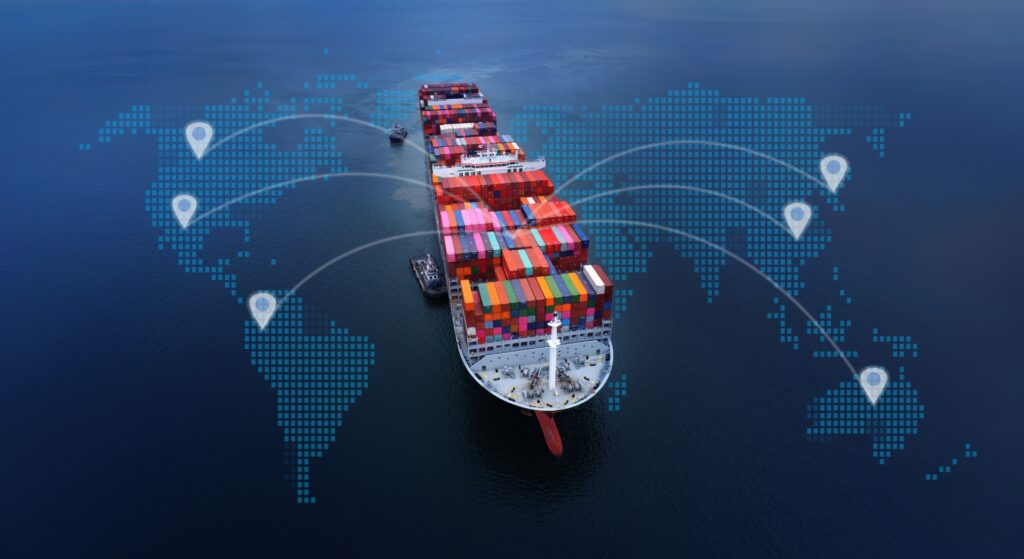The terms transport and logistics are often used interchangeably, but in fact, have very different scopes of coverage. In this comprehensive guide we will:
- Define the key differences between these terms
- Show how logistics fits into the process flow of an international transaction
- Examine the different transportation methods available and describe their pros and cons
- Explain some of the key terminology you need to know
- Give an overview of some of the most common careers in these industries
Finally, we will also look at how the COVID-19 pandemic has influenced the transport and logistics industries.
Let’s get started.
What is the difference between transport and logistics?
The transportation industry focuses on the actual movement of products via ground, ocean, and air conveyances (methods of transport). Logistics covers a much broader scope of activities that facilitate the management of product movement within the supply chain.
The activities undertaken in logistics include demand forecasting, export packaging, carton labelling, order management, inspection, transportation management, customs clearance, warehousing, and distribution activities to name a few. The activities that facilitate the transport of products internationally are a subset of the logistics industry.
The logistics industry concentrates on planning activities that manage product movement, as well as the necessary data and documentation for cost efficient cross border commerce.
How does logistics fit into an international transaction?
The diagram below demonstrates how data and documents that support international shipments flow from the inception of the order through warehouse delivery.

The logistics process begins with the placement of the purchase order.
Sourcing, traffic, import and production personnel input data on terms of sale, classification, documentation, routing, labelling and testing requirements. All of these affect the efficient movement of the cargo and must be communicated to the vendor.
Once the product is ready for shipment the vendor must provide an advanced shipping notice (ASN). Usually this is done through an intermediary known as a freight forwarder. The freight forwarder works with the appropriate carrier to secure space and equipment to load the cargo.
Concurrently, import personnel require the necessary documentation to facilitate the import process. The shipment information will be communicated to a customhouse broker who will assist in clearing the shipment through customs and, if required, other government agencies.
The shipment information must also be advised to the import trucker and import warehouse so that delivery can be coordinated. The warehouses must prepare space for the shipment and communicate receiving information back to payment coordinators. Warehouses can then coordinate domestic distribution of the product.
The timing of all this information is critical, as is the integrity of the data. Gaps and misinformation create delays and increase costs.
What are the different transportation methods and why do shippers choose a particular method of shipment?
The “Father of Containerization”, Malcolm McClean, once answered the question, “What is freight?” by saying “Freight is something that you add to the cost of your product. If the cost of freight is too high, the product won’t move. Freight is important.”
There are four modes of transportation employed for the movement of consumer goods in international trade, vessel (water), motor freight, rail, and air. The use of a certain mode of transport, is driven by the varying importance of a range of factors:
- Cost (The carrier’s charge for the transport of the shipment)
- Speed (The time anticipated to complete, or the urgency of, the shipment)
- Security (Likelihood of pilferage or damage)
- Capacity (The volume of cargo that can be delivered)
- Flexibility (Availability of service and how customizable is the time of shipment)
- Environmental Impact (Is shipping being done in the most environmentally friendly way)
Let’s examine each of the transportation methods one by one.
Motor freight (Road) ⛟
Motor freight is one of the two available forms of ground transport and is the movement of cargo by truck. In international trade, this most often involves the use of ‘semis’ in North America and ‘cab-overs’ in Europe. These trucks are engineered to haul containers mounted on chassis. When properly managed, and trade flows allow for it, a trucker can deliver a full container and return with another.
The sole use of ground transport for the international movement of cargo is attractive when the size of the shipment is a truckload or less, if the merchandise is moving between countries located in the same region or hemisphere, and the distance the cargo is traveling is not prohibitive. This can allow for the most time efficient movement of cargo as the cargo can go from point to point, without reloading to another conveyance.
Motor freight is the most flexible form of transport as delivery to fixed terminals is not necessary. It is the only form of international transport that offers door to door service without repositioning of the cargo. From an environmental standpoint, motor freight is not environmentally friendly and is second only to airfreight in the amount of carbon emissions produced per ton-mile.
Speed, Flexibility
Cost, Capacity, Security, Environment
Rail (Ground Transport) 🚄
Rail transport, similar to motor freight, is feasible when cargo is being moved between countries located in the same region or hemisphere. Rail transport allows for the shipment of greater volumes of cargo, at higher speeds, over longer distances, with greater security, at a lower cost and a lower environmental impact. Rail cargo is not as flexible as motor freight and must be delivered to and picked up from fixed terminals. Transport is limited to fixed routes. It is often used as part of the intermodal movement of cargo.
Cost, Speed, Capacity, Environment, Security
Flexibility
Water Transport 🚢
Consumer products traditionally move via container vessel. The adoption of the shipping container reduced handling costs for ocean freight by 98.5%, and set the stage for the degree of globalization that exists for mass market consumer goods today. Not surprisingly 95% of all international cargo, by volume, moves by ocean vessel.
Ocean freight has a number of advantages. It can be used to move both large and small volumes of cargo. Smaller volumes for multiple shippers are consolidated into containers via freight forwarding services. Larger shipments are shipped in containers carrying only one importer’s merchandise. Containers vary in size with the most common being 20- and 40-foot containers.
It is the most cost-efficient shipping method and produces the least environmental impact. Conversely it has longer transit times, is confined to fixed routes, and requires extensive handling and infrastructure.
Cost, Capacity, Security, Environment
Speed, Flexibility
Air Transport ✈
The movement of cargo via aircraft is noted for its speed, cost and capacity limitations. For that reason, it is best suited for high-value, lower volume products and/or perishable products that require urgent time-sensitive delivery. Cargo moves both via passenger planes and cargo planes.
Billing is based on an actual weight vs. dimensional (volume) weight calculation. The charges billed to the shipper will be based on the calculation that produces the higher revenue. This discourages the shipment of low weight, bulky items. Transport is between fixed points and this form of transportation has the highest environmental impact per ton-mile.
Speed, Security
Cost, Capacity, Flexibility, Environment
Multimodal or Intermodal ⛟ ⛴ 🚃 ⛟ ✈
Intermodal means that one service provider coordinates the movement of freight via multiple conveyances, under one ‘thru bill of lading’. As mentioned previously, motor freight is the only form of transportation that can truly function in isolation. Movements via rail, water or air require a delivery to fixed terminals where the cargo is loaded for transport. These shipments are not considered intermodal when coordinated by different parties.
Ocean carriers and freight forwarding services can coordinate door to door delivery of cargo, transferring cargo between motor carriers, vessels, rail, etc. Intermodal freight is seen in various ‘land bridge’ services coordinated by ocean carriers. In these instances, ocean carriers will deliver goods to a particular port, and then coordinate the container movement inland, either by motor freight, or where infrastructure allows for it, rail freight.
Conversely, they will pick up goods at an inland point and deliver the container for export to a specific port. This is very common when shipments need to move to or from distant inland points. However, multimodal services can be limited, or not available at all in underdeveloped and landlocked countries.
Small package services such as FedEx or UPS consolidate small packages into larger shipments and coordinate multimodal movements for those seeking to move smaller quantities of cargo.

International Logistics and Sourcing
Transport and logistics glossary – terms to know
Below we have listed some of the key terms that transport and logistics professionals need to understand. They will also be useful to others who don’t work directly in these industries, but frequently interact with those that do. Click on any of the terms to see the definition.
Conveyance
EDI – Electronic Data Interchange
ASN – Advance Shipping Notice
Commercial invoice
Demurrage
Detention
FCL/FTL
LCL/LTL
CY – Container Yard
CFS – Container Freight Station
Certificate of Origin
Bill of Lading
Inspection Certificate
Insurance Certificate
Incoterms® rules
World Customs Organisation
ATA Carnet
Export quotas
Tariffs
Customs classification
Letter of credit
Transport and logistics careers
Whether you are interested in pursuing a career in the logistics or transport industries or are already part of it, there are a wide variety of positions and specialisms you can consider. Below we have listed some of the most common positions and roles available.
Traffic manager
Traffic managers are specialists who analyse import and distribution routes along with product volumes to develop strategic plans for the purchase of transport services. They work directly with carriers and intermediaries, such as freight forwarders. They supervise traffic coordinators who arrange shipments on a transactional basis. They provide critical information and support to production, costing, warehousing and sales departments.
Import manager
Import Managers are specialists who analyse product orders to provide proper product classification, communicate required import documents and certifications to suppliers, and ensure customs clearance without impediment. They select and purchase services from customhouse brokers. They supervise import coordinators who arrange customs entries on a transactional basis. They provide critical information and support to production, costing, warehousing and sales departments.
Import finance coordinator
Import Finance coordinators process letter of credits, documentary presentations, or wire transfers in accordance with purchase agreements. They work closely with production, warehousing and finance departments.
Freight forwarder
Freight forwarders are transportation intermediaries that resell the cargo space of air, ocean and ground carriers. They act as a type of travel agent for merchandise. Freight forwarders assist clients with the consolidation of cargo from multiple suppliers. These intermediaries often provide order management and IT services for their clients.
Customhouse broker
Customhouse brokers are intermediaries who assist importers with the Customs clearance of their imported products. They complete and file the forms necessary for entry, and assist importers with applying the proper classification to their products. The United States, Canada and Australia are among a number of countries which license individuals and corporations to transact customs business. In European Union customhouse brokers or clearing agents are not licensed.
Warehouse Manager
Warehouse managers coordinate the receipt, storage, staging and distribution of goods. They are involved in the purchase and adoptions of warehouse management systems. They oversee the organization of the inventory and track inventory levels.
Export Packers
Export packers assist shippers in multiple ways. They can ensure that companies secure optimal loads of their freight through the redesign of packaging. They can provide specialized packing services that ensure that products are properly secured within containers. They are used to meet rigorous vendor requirements for carton labelling when goods are delivered direct to retail distribution centres or cross-dock facilities.
COVID-19 and the future
The worldwide COVID-19 pandemic has had a profound impact on the international transport of goods, disrupting supply chains globally. This has caused a sequence of events to repeat itself in freight markets around the globe.
In ocean freight, a drop in demand for cargo space in early 2020 has now been followed by an ever-increasing demand that has driven prices steadily upward in the ocean markets. The last four months have seen an unprecedented surge in global container pricing.
The air markets, which rely heavily on passenger flights for capacity, were radically impacted by a 75% reduction in international passenger flights during 2020 (IATA). This resulted in similar pricing surges for cargo. This increase in volume further was complicated by labour shortages at ports, warehouses, and in the motor freight industry.
The cumulative effect of these conditions in early 2021 has been growing congestion at ports that currently shows no signs of abating. On the West Coast of the United States an average of 30 ships now sit at anchor for approximately a week before berthing. Vessels and equipment are thus delayed in their return to their points of origin to load additional freight. In response, carriers cancel port calls, and the cycle continues.
It is likely that the pandemic experience will serve as an accelerator for the adoption of more automated systems within the supply chain. We should also see a greater diversification in sourcing, coupled with the development of an enhanced degree of regional self-sufficiency.
The industry and/or governments must find a way to alleviate severe congestion at ports. Demand surges, accidents, or even weather that impact the flow of goods creates bottlenecks that take months to correct. The end result is a loss of sales, escalating prices and consumer frustration.

International Logistics and Sourcing
Additional resources
Logistics Performance Index: Published by the World Bank, this is a survey that is usually done every two years. It ranks countries in six areas of performance in logistics and provides an overall ranking for over 160 countries.
Pier2Pier.com: Pier2Pier.com is a low-cost subscription website that offers 3 months free access. It offers a host of resources, the ones this author finds of most interest are:
- 3D Load Calculator – which allows you to enter the carton dimensions of your cargo and see an estimated cargo load.
- Links to Carrier Websites
- A Transport Route Search – which allows you to enter an origin and destination port and then displays vessels that have completed this routing and their transit times.
- Educational Tests
- Links to Industry Publications




